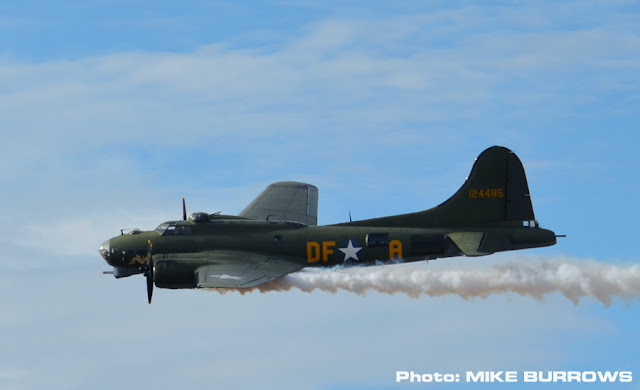A few photos from Saturday's Southport Airshow...
The EurofighterTyphoon, the world's most advanced multi role/swing role combat aircraft, capable of reaching speeds of Mach 2, or around 1,400 mph
.
Below, the de Havilland Vampire pair.
The de Havilland DH100 was the second RAF jet fighter, following the Gloster Meteor to enter service towards the end of the Second World War, and served with front line defence until 1953. These two classic examples are maintained and flown by the Royal Norwegian Air Force Historical Squadron.
Above, the Mikoyan-Gurevich MiG 15, a formidable aircraft from the Soviet Union,which NATO code named Fagot, and was introduced in 1949. It achieved fame during the Korean War, and still remains in service as an advanced trainer for the North Korean Air Force.
Here's the MiG 15 flying in formation with the Vampire Par.
Below, the de Havilland Vampire pair.
The de Havilland DH100 was the second RAF jet fighter, following the Gloster Meteor to enter service towards the end of the Second World War, and served with front line defence until 1953. These two classic examples are maintained and flown by the Royal Norwegian Air Force Historical Squadron.
Above, the Mikoyan-Gurevich MiG 15, a formidable aircraft from the Soviet Union,which NATO code named Fagot, and was introduced in 1949. It achieved fame during the Korean War, and still remains in service as an advanced trainer for the North Korean Air Force.
Here's the MiG 15 flying in formation with the Vampire Par.
A pyrotechnic display on the beach, simulating a bombing run.
The Lancaster Bomber, part of the Battle of Britain Memorial Flight.
An Hispano Buchon, a licenced-built Spanish version of the German Messerschmitt Bf 109, developed during and following the Second World War. The Hispano is a re-engined ME 109.
The Spitfire, perceived by the public as the main RAF fighter plane during the Battle of Britain, although in reality it was the less glamorous, but outstanding Hawker Hurricane that shouldered more of the burden of resisting the might of the German Luftwaffe.
There were several civilian aerial displays including this from the Breitling Wingwalkers. who recreate the fearless glamour from times following World War 1, when returning pilots, addicted to the thrill of flying would persuade engineers and girlfriends to walk along their bi-planes linen wings .
The lady in the photo can pretty much do the job standing on her head!
There were several armoured vehicles on display. Above is a Russian Cold War BMP-1 Armoured Personnel Carrier.
Part of a parachuting display from one the members of the Tigers Free Fall Team.



















Beautiful clarity and close-up detail. More so when I consider the distance and speed involved. Difficult to pick a fave, as they're all of an exceptionally high standard. Well done, Scoop :)
ReplyDeleteThanks Tony. The Typhoon is the hardest to catch as it moves like lighting. I was pretty drained by the I caught a few decent shots of it. My favourite is the Vampire pair as, even though they first appeared in the forties I find them so retro futuristic.
DeleteI agree Scoop. top photography. You should be the official photographer for the show! I can't see anyone else's being better. I'm amazed they blow up part of the beach like that. I assume the whole area is sealed off?
ReplyDeleteCheers Woodsy. They do indeed cordon of the beach for the pyrotechnics. Some of the planes do bombing runs culminating rapid explosions, which much to everyone's amusement, set off most of the car alarms parked on the shore.
DeleteTerrific stuff Scoop , I particularly like the Cold War jets. Good work sir !
ReplyDeleteFenton
Thanks Fenton, yeah the MiG especially is amazing, so fast, yet so quiet.
DeleteThe Soviets had the Atlee Gov. to thank for that - as a gesture of goodwill they gifted them some brand new Rolls Royce engines and also whilst on a postwar diplomatic tour of a British aircraft factory , the Soviet Air Attaché purposely wore soft rubber soled shoes while walking through the lathe cutting hall so that Soviet metallurgists could do research on which metals we were using to make Hunters, Canberras etc - sneaky lot ! ;-)
DeleteFenton
Sneaky indeed, Fenton, and some good info there. Yes, the Russians reverse engineered them and later Rolls Royce tried unsuccessfully to claim back millions of pounds in licence fees. Giving away your best engines to your Cold War rivals seems a daft thing to do, really :D
Delete